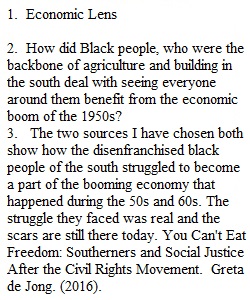


Q HIS 200 Module Five Short Response Guidelines and Rubric Overview: The short response activities in the webtext throughout this course are designed to show your understanding of key concepts as you engage with course content. Prompt: During the fifth week of the course, you will respond to several questions in the webtext as you complete each learning block. At the end of Module Five, you will review your answers to these questions and ensure that you have responded to each question. It is important that you answer each question, otherwise, the words “[no response]” will appear in brackets when you submit the assignment. The questions and their original locations in the webtext are listed in this table in case you want to refer back to the reading as you edit, but you can edit your responses to all the questions directly in Module Five: Analyzing History, learning block 5-4 (page 5) in the webtext, before exporting to Word for submission to your instructor in the learning environment. Module Five: Analyzing History, Learning Block 5-1 (page 1): Bullet Bullet Question 1: In the space below, specify which historical lens you would like to use for this exercise. Bullet Bullet Question 2: Next, formulate a research question about the civil rights movement (historical time from 1954–1968), using the lens you have chosen. Module Five: Analyzing History, Learning Block 5-1 (page 2): Bullet Bullet Question 3: First, go back and review the research question you developed in Step 1. For Step 2, first name two different primary sources that you might use to answer that question. Be as specific as you can. Your primary sources should be found using the Shapiro Library. Bullet Bullet Question 4: Next, name two different secondary sources you could use to answer your research question. Again, be as specific as you can. Your secondary sources should be found using the Shapiro Library. Module Five: Analyzing History, Learning Block 5-1 (page 3): Bullet Bullet Question 5: Construct a thesis statement that provides an answer to the research question you posed in Step 1. Base your response on the historical evidence that has been presented in this course so far, as well as any research you may have done on your own. Module Five: Analyzing History, Learning Block 5-3 (pages 2–3): Bullet Bullet Question 6: Name three specific historical events that can be considered contributory causes of the passage of the Voting Rights Act. Briefly explain why you believe each of these events contributed to the passage of the Act. Bullet Bullet Question 7: Based on what you read about the passage of the Voting Rights Act on page 1 of this learning block, name one event that was part of the course of this bill’s passage by Congress. Bullet Bullet Question 8: Name three specific consequences caused by the passage of the Voting Rights Act. Bullet Bullet Question 9: One of these scholars relied heavily on evidence about the substance of today's political debate. Which scholar was that? What sort of evidence did he use? Bullet Bullet Question 10: One of these scholars relied heavily on evidence about the political process. Which scholar was that? What sort of evidence did he use? Module Five: Analyzing History, Learning Block 5-4 (page 5): Bullet Bullet Question 11: 1. 1. What is the topic of this essay? Does the author make it clear in the introduction? 2. 2. What is the author’s thesis? 3. 3. What kind of sources and evidence do you think the author will use to support his thesis? Rubric Guidelines for Submission: Your response to Questions 1, 2, 3, 4, and 5 should be 1–2 sentences in length. Your response to Questions 9, 10, and 11 should be 2–3 sentences in length. Follow the instructions at the bottom of Module Five: Analyzing History, learning block 5-4 (page 5) in the webtext, to download your work and submit it to your instructor as a single Microsoft Word document uploaded to the learning environment. Refer to the Submitting Webtext Assignments Guide for assistance on downloading, saving, and submitting this assignment. Critical Elements Exemplary Proficient Needs Improvement Not Evident Value Engagement Written responses completely address all short answer prompts (100%) Written responses completely address the majority of short answer prompts (85%) Written responses address the minority of short answer prompts (55%) No written responses provided to address any short answer prompts (0%) 30 Relevance Written responses directly address short answer prompts, drawing from presented course concepts and terminology (100%) Written responses are topically related to short answer prompts, but responses do not consistently draw from presented course concepts and terminology (85%) Written responses do not address topics identified in short answer prompts (0%) 20 Accuracy Written responses are completely accurate (100%) Written responses contain minor errors but are mostly accurate (85%) Written responses contain major errors (55%) No written responses are provided (0%) 20 Critical Thinking Written responses demonstrate understanding of course content through inclusion of original ideas and examples (100%) Written responses demonstrate understanding of course content through reiteration of provided materials, but do not consistently include original ideas and examples (85%) Written responses do not reflect original ideas and examples (0%) 20 Critical Elements Exemplary Proficient Needs Improvement Not Evident Value Articulation of Response Written responses are captured in complete sentences without grammatical errors impacting legibility and the clarity of response (100%) Written responses are captured in incomplete sentences or include numerous grammatical errors that negatively impact legibility and the clarity of response (85%) No written responses are captured in complete sentences (0%) 10 Total 100%
View Related Questions